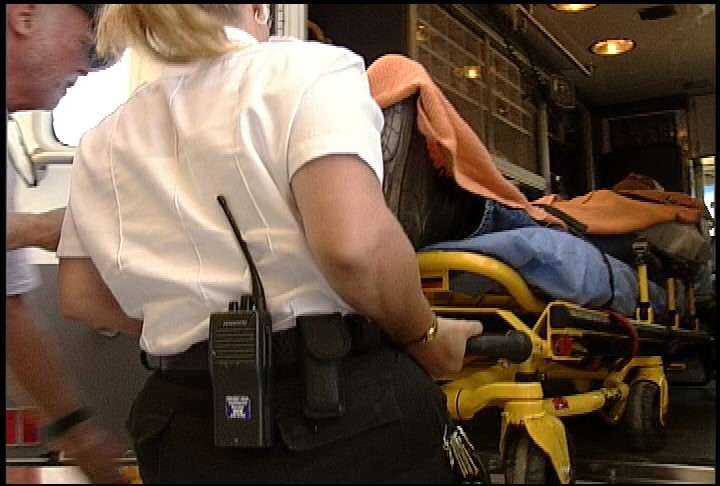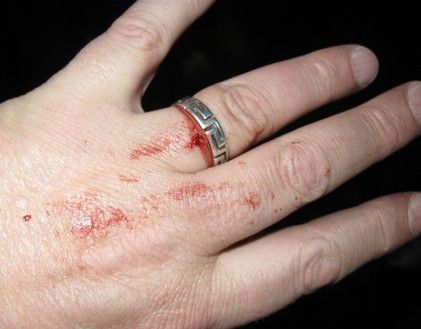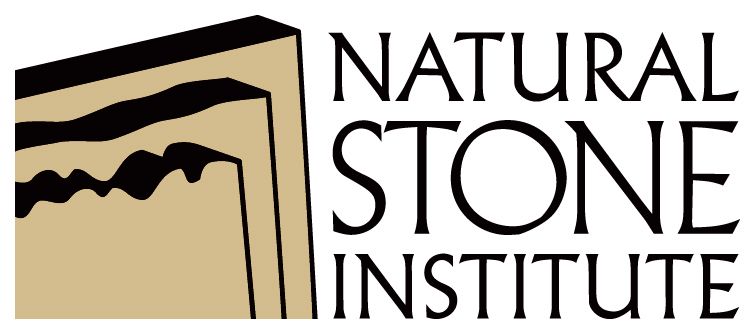
Loose Fit ... and Lose It?
Hazards with Clothes, Gloves, Long Hair, Jewelry.
Photo courtesy Natural Stone Institute
Work in the manufacturing and construction industries exposes owners and employees to the hazards of machinery or equipment with moving parts.
Loose clothing, gloves, jewelry, and long hair can get caught in moving parts and cause serious injury or death.

"blood" by skuds is licensed under CC BY-SA 2.0
It's the Little Things ....
Don't think these are really job hazards? Consider: .:
• A worker was cutting masonry blocks with a gas-powered concrete cut-off saw when muffler exhaust blew a loose portion of his shirt tail into the spinning saw blade, causing a severe laceration on his left arm. • A worker was cleaning a conveyor belt when the moving belt caught his shirt-sleeve. His finger was fractured. • A worker trimming wood on a trim saw when the guarded blade caught his glove, lacerating three of his fingers (which then had to be partly amputated). • A worker was inspecting the cutter-head tool attachment on a milling machine when he accidentally activated the power lever. The attachment caught the worker's ring, severing his finger. • A worker was injured when his glove became caught while using a rebar bender. His right thumb was amputated at the first knuckle. • After changing the tool on a CNC machine, a worker was checking the depth of the first cut without stopping the rotary motion of the tool. His hair was caught by the tool and pulled from his scalp.
From the Files
A 35-year-old stone-distribution warehouseman (employee #1) had finished unloading a 16’ flatbed truck. Realizing he left a few tools behind, employee #1 climbed back onto the truck to retrieve them. He stepped onto a truck-mounted foothold and grabbed a truck-mounted handhold with his left hand. Employee #1 grabbed the tools he had been using with his right
hand. As he stepped off the truck, the ring on his left ring finger caught on a bracket used to mount the handhold to the truck's cab. The force of the employee's weight and momentum caused his finger to be severed at the second knuckle. Emergency medical services were called. The employee was hospitalized for his injury.
Safety Habits to Live By
It takes a lifetime to make a safe worker, but it takes only a second to destroy it all with one accident. Take the time to work safely and to help your fellow workers to be safe. Dressing safely and appropriately for your job will reduce your risk of injury.
• Wear close-fitting clothing. • Tuck your shirt into your pants. • Button up the cuff buttons on long-sleeved shirts. • Do not wear gloves when working near rotating shafts or other moving machinery parts. • Seek approval from your supervisor if you must wear gloves for health and safety reasons. • Tie back long hair or wear appropriate hair protection to prevent hair from getting caught in moving parts of equipment. • Keep facial hair short so it won’t be caught by moving machinery parts. • Do not wear jewelry at work. OSHA does not forbid jewelry on the job in most cases. It’s a recommended consensus standard for increased safety (e.g., ANSI O1.1-2009). • If you wear a medical-alert bracelet, secure it snugly to your skin with transparent surgical of adhesive tape. • Always use the appropriate safeguards. Any machine part, function, or process that may cause injury must be safeguarded.

Photo by Payem Tahery - Unsplash
Reminder: Safety is the responsibility of both management and employees!
All Natural Stone Institute Safety Resources and Courses are offered free at www.uofstone.com and www.naturalstoneinstitute.org/safety.
The information herein is provided by the Natural Stone Institute as a general summary for use in job site toolbox talks and is provided to augment and not substitute for or replace required training under any applicable local, state or federal workplace statute, law or regulation. It is the user’s responsibility to ensure this content is consistent with job site requirements and applicable statutes, laws or regulations prior to use and make any required additions or changes.
